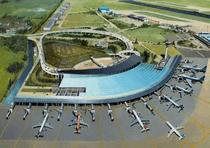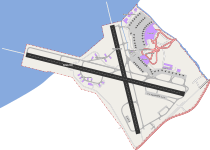Thessaloniki Airport
| Thessaloniki International Airport "Macedonia" Κρατικός Αερολιμένας Θεσσαλονίκης "Μακεδονία" | |||||||||||||||
|---|---|---|---|---|---|---|---|---|---|---|---|---|---|---|---|
|
| |||||||||||||||
| IATA: SKG – ICAO: LGTS | |||||||||||||||
| Summary | |||||||||||||||
| Airport type | Military/Public | ||||||||||||||
| Owner | Greek state | ||||||||||||||
| Operator | Fraport AG/Copelouzos Group joint venture | ||||||||||||||
| Serves | Thessaloniki | ||||||||||||||
| Location | Mikra, Macedonia, Greece | ||||||||||||||
| Hub for | |||||||||||||||
| Elevation AMSL | 7 m / 23 ft | ||||||||||||||
| Coordinates | 40°31′11″N 22°58′15″E / 40.51972°N 22.97083°ECoordinates: 40°31′11″N 22°58′15″E / 40.51972°N 22.97083°E | ||||||||||||||
| Website | ypa.gr | ||||||||||||||
| Maps | |||||||||||||||
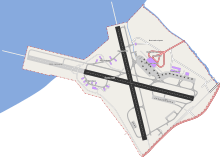 Map of the airport | |||||||||||||||
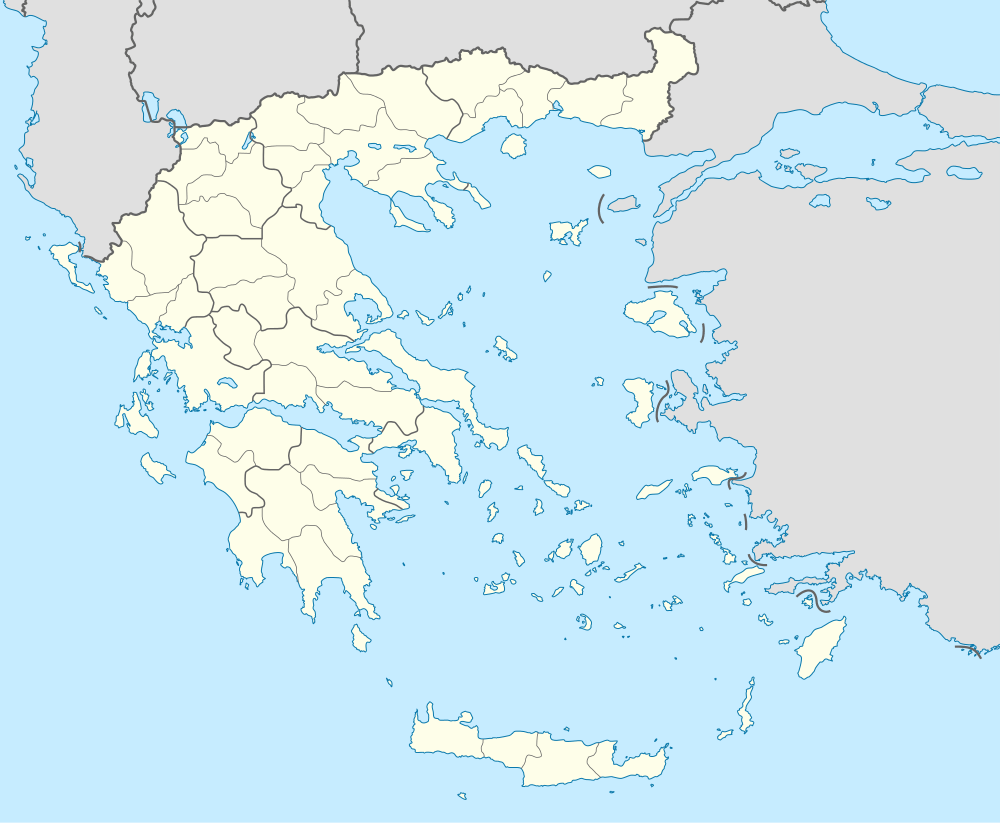 SKG Location of the airport in Greece | |||||||||||||||
| Runways | |||||||||||||||
| |||||||||||||||
| Statistics (2015) | |||||||||||||||
| |||||||||||||||
|
Sources: Greek AIP at Eurocontrol[1] Statistics: Hellenic Civil Aviation Authority[2] 1 Official airfield data at the Air Traffic Safety Electronic Engineers Association of Hellenic Civil Aviation Authority website lists no official website for the airport. | |||||||||||||||
Thessaloniki International Airport "Macedonia"[2] (Greek: Κρατικός Αερολιμένας Θεσσαλονίκης "Μακεδονία",[3] Kratikós Aeroliménas Thessaloníkis "Makedonía") (IATA: SKG, ICAO: LGTS), formerly known as Mikra Airport, is located 7 nautical miles (13 km; 8.1 mi) south[4] of the White Tower of Thessaloniki in Greece at Thermi.[1]
The airport is the third largest airport in the country after Athens International Airport and Heraklion International Airport. It opened in 1930 and was the second busiest airport in Greece in terms of flights served and the third busiest in terms of passengers served in 2015, with over 5 million passengers. It is the main airport of Northern Greece and serves the city of Thessaloniki (the second-largest city in Greece), the popular tourist destination of Chalkidiki and the surrounding cities of the region.
History
During World War I the area that the airport currently occupies was used as an airfield and it continued operating as an airfield during World War II. At the time of the German occupation of Greece major projects took place, such as the creation of a 600 metres (2,000 ft) runway, while in 1948 the airport started operations as a civil airport for the first time.
In 1950 the already existing (10/28) runway got paved with asphalt at a length of 1,800 m (5,900 ft) and in 1952 it was extended to 2,000 m (6,600 ft). It was the same year that the first airport building was completed, with a control tower on the roof. One year later a new runway (16/34) was built. In 1958 the runway 10/28 underwent reconstruction and was extended to a total length of 2,440 m (8,010 ft) (current length), while runway 16/34 was extended to 2,400 m (7,900 ft), with its completion in 1972. In 2004 a new parallel taxiway for runway 16/34, was opened for use.
In September 1965 a new terminal building opened on a new location (current location). In the period between 1968 and 1973, the terminal was expanded, with the construction of a second floor and its first motorway junction. Due to the 1978 Thessaloniki earthquake, the control tower was destroyed, so a new one was constructed, independent of the main terminal building. The next expansion of the terminal took place in two stages, with the projects starting in 1991 and 1993 respectively. The municipality of Thessaloniki, as a European Capital of Culture for 1997, took over a projects for the aesthetic intervention, renovation, modernisation and reorganisation of the spaces of the building.
The terminal building took its current form, when an additional of 19,000 m2 (200,000 sq ft) were added to the western and eastern side of the terminal building, completed in November 2000 and June 2003 respectively. The western extension included the widening of the international departures area (new Extra-Schengen Area), including new administration offices, a new health station and the new station control of Olympic Airlines. The eastern expansion included a new check-in hall, new waiting halls and additional administrative offices for airlines. Today the terminal has a total floor area of 32,000 square metres (340,000 sq ft). Finally, during 2004–2006 the new motorway junction was completed on the level of the departures entrance of the Terminal and new parking spaces for cars, buses and taxis were created. In 1992 the airport changed its name from Micra to Macedonia.[5]
In June 2015, there was an important event in the history of the Macedonia airport and the Hellenic aviation. SkyGreece Airlines opened the first regular transatlantic flight coming from Toronto, Canada via Budapest, Hungary, due to the short runway of the Airport. The flight was scheduled to operate once a week during summer, but SkyGreece Airlines ceased all its operations in late August 2015, due to lack of funds and blaming the capital controls.
In December 2015 the privatisation of Thessaloniki Airport and 13 other regional airports of Greece was finalised with the signing of the agreement between the Fraport AG/Copelouzos Group joint venture and the state privatisation fund.[6] "We signed the deal today," the head of Greece's privatisation agency HRADF, Stergios Pitsiorlas, told Reuters.[7] According to the agreement, the joint venture will operate the 14 airports (including Thessaloniki Airport) for 40 years as of autumn 2016.
Facilities
Terminal
The airport's terminal consists of three floors. The ground floor serves arrivals only and is divided into two sections: international/extra-Schengen arrivals and domestic/intra-Schengen arrivals. The first floor serves departures and also includes a shopping center. On this floor there are 34 check-in counters, waiting areas, bars, stores that sell tobacco and magazines and various airlines' offices. The second floor houses two restaurants and several bars with views to the runways.
Inside the airport there is one restaurant, four coffee-bars and a tobacco store. Furthermore, except from the duty-free shop, there are stores selling traditional products, jewellery, accessories and clothes. Passengers also can utilize a luggage secure-wrapping service and luggage lockers. An Hellenic Post post office and automated teller machines are available on the passengers' departure area. There is also an office of the Greek National Tourism Organization. Finally, car hire companies can be found in the airport such as AVIS, Europcar, Hertz and Sixt.
There are two passenger lounges at the airport:
- Aegean Club Lounge, used by business class passengers of Aegean Airlines and Olympic Air and Star Alliance Gold members.
- Manolis Andronikos Lounge, operated by Skyserv[8]
Runways
The airport has two runways (10/28 and 16/34) and two taxiways. There are 22 stands for narrow-body aircraft and about 20 for light aircraft.
Airlines and destinations
Statistics
Overview
Between 1994 and 2010, Thessaloniki Airport saw a rise in passenger traffic equal to 76%, from 2.2 million in 1994 to 3.9 million in 2010.[2] Between 2003 and 2008 the airport saw a passenger traffic increase of 19.1% from 3.5 million to almost 4.2 million passengers, an all-time high. The number of passengers dropped in next years. However, over the last two years the airport experienced passenger traffic increase to just above four million by 2013. Significant traffic increase took place during 2014, with the total number of passengers exceeding the five million mark for the first time.[2]
Flights per week
| Rank | Destination | Airport(s) | December 2016 | Top carriers |
|---|---|---|---|---|
| 1 | |
ATH | 124 | Aegean Airlines, Ellinair, Ryanair |
| 2 | |
LGW, STN | 20 | easyJet, Ryanair |
| 3 | |
LCA | 17 | Aegean Airlines, Blue Air, Cobalt Air, Ellinair |
| 4 | |
HER | 15 | Astra Airlines, Ellinair, Olympic Air |
| 5 | |
IST | 14 | Turkish Airlines |
| |
MUC | 14 | Aegean Airlines | |
| 6 | |
SFX | 13 | easyJet, Ryanair |
| 7 | |
DUS, NRN | 12 | Aegean Airlines, Eurowings, Ryanair |
| 8 | |
CHQ | 11 | Olympic Air, Ryanair |
| 9 | |
STR | 10 | Aegean Airlines, Germanwings |
Figures
Apart from passengers, the airport also handled 8.2 thousand tons of freight in 2010, a considerable drop from the 21.4 thousand tons it handled in 1997.[2]
|
|
| |||||||||||||||||||||||||||||||||||||||||||||||||||||||||||||||||||||||||||||||||||||||||||||||||||||||||||||
Ground Transport
Thessaloniki Bus Route No. 78N | ||||||||||||||||||||||||||||||||||||||||||||||||||||||||||||||||||||||||||||||||||||||||||||||||||||||||||||||||||||||||||||||||||||||||||||||||||||||||||||||||||||||||||||||||||||||||||||||||||||||||||||||||||||||||||||||||||||||||||||||||||||||||||||||||||||||||||||||||||||||||||||||||||||||||||||||||||||||||||||||||||||||||||||||||||||||||||||||||||||||||||||||||||||||||||||||||||||||||||||||||||||||||||
|---|---|---|---|---|---|---|---|---|---|---|---|---|---|---|---|---|---|---|---|---|---|---|---|---|---|---|---|---|---|---|---|---|---|---|---|---|---|---|---|---|---|---|---|---|---|---|---|---|---|---|---|---|---|---|---|---|---|---|---|---|---|---|---|---|---|---|---|---|---|---|---|---|---|---|---|---|---|---|---|---|---|---|---|---|---|---|---|---|---|---|---|---|---|---|---|---|---|---|---|---|---|---|---|---|---|---|---|---|---|---|---|---|---|---|---|---|---|---|---|---|---|---|---|---|---|---|---|---|---|---|---|---|---|---|---|---|---|---|---|---|---|---|---|---|---|---|---|---|---|---|---|---|---|---|---|---|---|---|---|---|---|---|---|---|---|---|---|---|---|---|---|---|---|---|---|---|---|---|---|---|---|---|---|---|---|---|---|---|---|---|---|---|---|---|---|---|---|---|---|---|---|---|---|---|---|---|---|---|---|---|---|---|---|---|---|---|---|---|---|---|---|---|---|---|---|---|---|---|---|---|---|---|---|---|---|---|---|---|---|---|---|---|---|---|---|---|---|---|---|---|---|---|---|---|---|---|---|---|---|---|---|---|---|---|---|---|---|---|---|---|---|---|---|---|---|---|---|---|---|---|---|---|---|---|---|---|---|---|---|---|---|---|---|---|---|---|---|---|---|---|---|---|---|---|---|---|---|---|---|---|---|---|---|---|---|---|---|---|---|---|---|---|---|---|---|---|---|---|---|---|---|---|---|---|---|---|---|---|---|---|---|---|---|---|---|---|---|---|---|---|---|---|---|---|---|---|---|---|---|---|---|---|---|---|---|---|---|---|---|---|---|---|---|---|---|---|---|---|---|---|---|---|---|---|---|---|---|---|---|---|---|---|---|---|---|---|---|---|---|---|---|---|---|---|---|---|---|---|---|---|
| ||||||||||||||||||||||||||||||||||||||||||||||||||||||||||||||||||||||||||||||||||||||||||||||||||||||||||||||||||||||||||||||||||||||||||||||||||||||||||||||||||||||||||||||||||||||||||||||||||||||||||||||||||||||||||||||||||||||||||||||||||||||||||||||||||||||||||||||||||||||||||||||||||||||||||||||||||||||||||||||||||||||||||||||||||||||||||||||||||||||||||||||||||||||||||||||||||||||||||||||||||||||||||
Public transport
The airport is served on a 24-hour basis by Thessaloniki Urban Transport Organization (OASTH);
- To downtown Thessaloniki
- 78/78A/78N
- To Chalkidiki bus station[19]
- 78A/79 to A. S. IKEA (Anatolikos Stathmos IKEA), catch bus number 36/36A/36B to Ktel Chalkidikis
- 78/78N to Emporiko Kentro stop, catch bus number 36/36A/36B from A. S. IKEA (Anatolikos Stathmos IKEA) OASTH bus terminus to Ktel Chalkidikis
- To Macedonia Intercity Bus Station,[20] where buses depart for many cities of mainland Greece, plus Corfu, Crete, Lefkada and Zakynthos. A map of the destinations served is hosted on the station's website[21]
- 78/78A/78N to T. S. KTEL (Termatikos Stathmos KTEL)
- To Thessaloniki's train station
- 78/78A/78N to N. S. Stathmos (Neos Sidirodromikos Stathmos)
- To the port of Thessaloniki
- 78 to Plateia Aristotelous stop, which is 500 m (1,600 ft) from the port
- 78N to Antigonidon stop, which is 700 m (2,300 ft) from the port
- To Albatrans bus terminus,[22] where buses depart for Albania
- 78/78A/78N to N. S. Stathmos (Neos Sidirodromikos Stathmos), buses depart from Giannitson street
- To Crazy Holidays,[23] where buses depart for Albania
- 78/78A/78N to N. S. Stathmos (Neos Sidirodromikos Stathmos), buses depart from Kalou Michail 14 street
- To Olympic Lines bus stop,[24] where buses depart for Hungary, Serbia and Slovakia (from 26is Oktovriou street)
- 78 to I.K.A. stop
- 78N to Kolomvou stop
In September 2010 it was announced that an extension of the under construction Thessaloniki Metro to the airport is under consideration. The manufacturing company considers the possibility of constructing the extension with an over-ground rail-based transportation system, such as a monorail.
Car and taxi
The airport is directly connected with the city's major road arteries in the southeast, the EO16 and the A25 (the Thessaloniki-Chalkidiki motorway) via the ΕΟ67; offering direct access via the Thessaloniki Inner Ring Road to the A1/E75 and A2/E90 motorways; making transportation to and from Thessaloniki Airport relatively easy. A total of 2,285 parking spaces for cars exist at the front of the terminal building and taxis are available at the designated taxi waiting area, located outside the arrivals exit. The taxi fare to the city center is approximately €15–20 from 5 am to 12 am, while from 12 am to 5 am expect to be charged an extra €10 for this particular route.
Future
As part of a comprehensive masterplan released by the government in 2002, several projects have been started to improve Thessaloniki Airport. Other than the building works on the current terminal, including the construction of a new cargo terminal, the masterplan features two major projects.
Runway extension
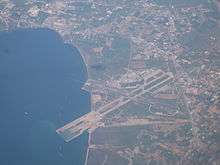
Phase 1 of the masterplan includes the expansion of existing runway 10/28 and is currently under construction. During the process of the project design, 80 Greek and 5 Danish civil engineers and scientists from other specialties have worked on the project. Both the runway and the taxiway will be extended by 1,150 m (3,770 ft), 1,000 m (3,300 ft) out into the sea, resulting in a runway that will have a total length of 3,440 m (11,290 ft) with an extra safety distance of 150 m (490 ft). Its width will be 50 m (160 ft) while the taxiway's width, which will be located at an axial distance of 183 m (600 ft) from the runway, will be 23 m (75 ft). The new runway and taxiway sections will be equipped with appropriate lighting and control systems, that will extend a further 750 m (2,460 ft) into the sea. The completion date was set in July 2011, but due to financial problems of the manufacturing company, reactions of environmental organizations and residents of the surrounding areas, fearing ecological dangers by extending land into the sea, the project has been held back. A new completion date for December 2012 was set,[25][26] only to be pushed further back to July 2013 and then December 2015.[27][28] The expansion of the runway will allow for the landing of larger aircraft, such as the Boeing 747 and Airbus A380, and increase safety, as the aircraft will have greater flexibility and visual contact on days with bad weather conditions.
Terminal 2
Phase 2 of the masterplan has heralded the construction of a new larger terminal, together with a new apron for 36 aircraft, of which 14 will be stationed at contact place. The second phase of the masterplan will drastically increase the status of the airport and eliminate existing passenger traffic problems, especially during the summer period. The new terminal will be able to accommodate 8 million passengers per year (in peak hours 2.800 passengers for departures or arrivals) while the terminal's total area is expected that it will be 115,000 m2 (1,240,000 sq ft).[29] In December 2010, the Greek government revealed that there are thoughts for the construction of the new terminal through private investing, the same way in which Athens International Airport was realised. It's highly plausible that Fraport AG/Copelouzos Group joint venture, which in 2016 took over the control of the airport, will realise the construction of Terminal 2, in order to upgrade its status as a regional transport hub.
| Macedonia International Airport masterplan | ||||
|---|---|---|---|---|
|
Accidents and incidents
- On 12 August 1997, Olympic Airways Flight 171, a Boeing 727-230 registered as SX-CBI inbound from Athens Ellinikon Airport, touched down late and was steered off the runway to avoid overrunning into the sea. None of the 35 passengers and crew were killed, but the aircraft was damaged beyond repair.[30]
- On 17 December 1997, Aerosvit Flight 241, a Yakovlev Yak-42, operating the route from Odessa, Ukraine to Thessaloniki, lost contact with the airport's air traffic control and during the second attempt the aircraft crashed in the Pierian Mountains, near Mount Olympus. A total of 70 people, passengers and crew, 41 of which were Greeks, were killed.
- On 4 July 2000, HA-LCR, a chartered Malév Flight 262 Tupolev Tu-154 landed on its belly. The crew had forgotten to lower the undercarriage and the plane skidded 400 m (1,300 ft) on the runway. Thanks to the plane's robust construction and the engines' high position, the plane was able to become airborne again as the pilots applied full throttle. It circled while the crew lowered the undercarriage and landed safely. There were no injuries. It was considered uneconomical to repair the aircraft. The aircraft still remains on site,[31] although airline markings have been obscured and heavily depleted of re-usable spares.
- On 15 June 2013, an AMC Airlines Boeing 737-800 on behalf of Astra Airlines Greece, registration SU-BPZ performing flight A2-921 from Novosibirsk (Russia) to Thessaloniki (Greece) with 160 passengers, landed on Thessaloniki's runway 16 at about 07:14L (04:14Z) but overran the end of the runway by about 110 meters/360 feet and came to a stop with all gear on soft ground. No injuries occurred, the aircraft received minor if any damage.[32]
See also
References
- 1 2 "EAD Basic". Ead.eurocontrol.int. Retrieved 12 July 2015. (registration required (help)).
- 1 2 3 4 5 "THESSALONIKI AIRPORT "MAKEDONIA"". Retrieved 3 April 2016.
- ↑ "ΚΡΑΤΙΚΟΣ ΑΕΡΟΛΙΜΕΝΑΣ ΘΕΣΣΑΛΟΝΙΚΗΣ "ΜΑΚΕΔΟΝΙΑ" (ΚΑΘΜ)". Retrieved 24 September 2015.
- ↑ Wind Direction and Degrees
- ↑ Macedonia: New Name for Thessaloniki Airport
- ↑ http://www.tornosnews.gr/en/tourism-businesses/new-investments/13859-greece-signs-privatization-of-14-regional-airports-with-germany-s-fraport-for-e1-2-bln.html
- ↑ http://uk.reuters.com/article/eurozone-greece-privatisation-idUKL8N1431P720151214
- ↑ "Airport Lounge Services". skyserv.aero. Retrieved 18 October 2015.
- ↑ http://www.astra-airlines.gr/pages.php?cat=10&n=141
- ↑ https://www.condor.com/eu/index.jsp
- ↑ http://en.ellinair.com/avia/flightprogramtimeline#?
- ↑ http://www.mouzenidis.gr/avia-table?CurPage=1&DepartureCityId=615&ArrivalCityId=1783&DaysFlow=0&DateFrom=17-06-2017
- ↑ http://www.mouzenidis.gr/avia-table?CurPage=1&DepartureCityId=615&ArrivalCityId=2663&DaysFlow=0&DateFrom=15-06-2017
- ↑ http://el.ellinair.com/
- ↑ http://www.mouzenidis.gr/avia-table?CurPage=1&DepartureCityId=615&ArrivalCityId=3343&DaysFlow=0&DateFrom=10-06-2017
- ↑ "Schneller Ausbau des Standorts Salzburg: Eurowings fliegt ab Frühjahr kommenden Jahres neu auch nach Palma de Mallorca, Olbia, Thessaloniki, Dubrovnik und nach Split / Flüge sind ab heute buchbar" [Fast expansion of Salzburg base: Eurowings from spring next year will fly also to Palma de Mallorca, Olbia, Thessaloniki, Dubrovnik and Split / Flights on sale from today] (in German). Eurowings. 15 September 2016. Retrieved 16 September 2016.
- 1 2 3 4 http://www.jet2.com/destinations#tab7
- 1 2 3 4 http://www.routesonline.com/news/38/airlineroute/269001/ryanair-expands-thessaloniki-routes-in-s17/
- ↑ Σας καλωσορίζουμε στην ιστοσελίδα μας
- ↑ καλώς ήλθατε
- ↑ Bus Information – Map
- ↑ Albatrans
- ↑
- ↑ Olympic Lines
- ↑ "ΔΕΛΤΙΟ ΤΥΠΟΥ". 5 July 2010. p. 14. Retrieved 3 November 2013.
- ↑ "Transatlantic flights in 2013" (in Greek). agelioforos.gr. 30 August 2011. Retrieved 1 September 2011.
- ↑ ""ΜΑΚΕΔΟΝΙΑ" Υπερατλαντικό αεροδρόμιο το 2015". Retrieved 9 March 2013.
- ↑ "Έγκριση 3ης Παράτασης προθεσμίας περαίωσης των εργασιών του έργου: "Επέκταση διαδρόμου προσαπογειώσεων αεροσκαφών 10–28 (μετά παραλλήλου τροχοδρόμου) Κρατικού Αερολιμένα Θεσσαλονίκης "ΜΑΚΕΔΟΝΙΑ""". 21 June 2013. Retrieved 3 November 2013.
- ↑ "Airport terminal masterplan" (in Greek). Aristotle University of Thessaloniki. Archived from the original on 23 March 2012. Retrieved 23 June 2011.
- ↑ "Accident description Olympic Airways SX-CBI". www.aviation-safety.net. Retrieved 12 June 2016.
- ↑ "Photos: Tupolev Tu-154B-2 aircraft". www.airliners.net. Retrieved 16 April 2011.
- ↑ http://avherald.com/h?article=463e0584
External links
![]() Media related to Thessaloniki International Airport at Wikimedia Commons
Media related to Thessaloniki International Airport at Wikimedia Commons
- Official website
- Accident history for SKG at Aviation Safety Network
- Current weather for LGTS at NOAA/NWS
